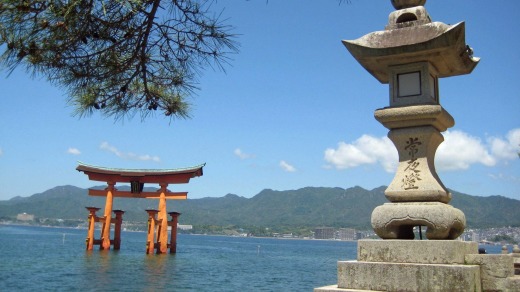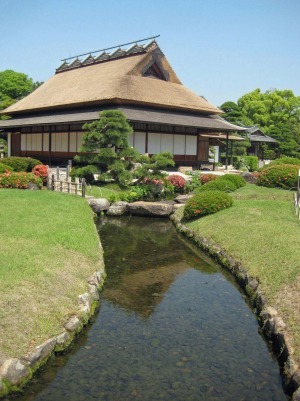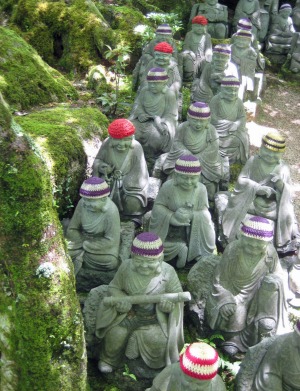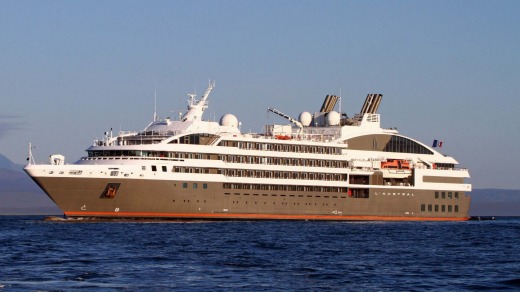I've never heard of Sakaiminato. I'd never have thought of coming here, but now my ship L'Austral is sailing into port and here I am. The docks are lined with used cars for export to Russia, beside fragrant piles of logs that the Russians send back to Japan. Birds of prey wheel in the sky over the fish market, waiting for an easy score. Across the bay, Mount Daisen volcano is a snow-drizzled pyramid.
I like arriving in places of which I've never heard. With no preconceived notions, there's an added element of titillation. I might be disappointed or I might be thrilled. In this respect, cruises are the ultimate tease. They have me ever moving onwards into unknown ports that are given only a few hours to make their mark. Sometimes that's enough, and I sail away satisfied. More often, I make a regretful return to the ship, feeling that there's more to explore.
So here I am in southern Japan, and Sakaiminato is our first port of call. Voila as they say, especially on L'Austral, a ship crewed by Frenchmen. At least with Ponant, with its small-ship focus on the destination, you get more than just a few hours. We're in port the entire day, and I'm off on a shore excursion called Izumo Mythological Town. I've never heard of that, either.

We pile into a coach and head off westwards on a road that cuts across semi-salty lakes ringed by hills and ginseng farms. Our local guide Iko calls this area remote, but it looks dense with villages and narrow, immaculate roads. We drive across bridges spanning tight valleys; below, grey-tiled houses are islands set in shimmering rice fields. As we pass the outskirts of Matsue the main road is lined with ugly buildings: an Isuzu dealer, Jumbo Palace restaurant, 7-Eleven, Mos Burger outlet (Japanese fine burger and coffee).
Our destination could hardly be a greater contrast. Izumo-taisha shrine is one of the oldest Shinto shrines in Japan, a sedate construction in wood and thatch set against a forested hillside. Today we're in luck: a festival is honouring a visit from the Emperor's messenger. Shinto priests process in lacquered clogs and blue robes, and the red-robed messenger un-scrolls a parchment and recites its contents as monks bow.
We stop in what looks like an industrial park for lunch in a boxy, concrete restaurant, but I'm not surprised the service is impeccable. Japan provides quality wherever you go. Our kaiseki meal is a succession of pretty little dishes: sashimi, broth of tofu and vegetables, delicate grilled fish eaten whole, beef hotpot, side dishes of pink and neon-green pickles.

On we go for an afternoon at Adachi Museum of Art, notable for its collection of contemporary Japanese paintings, but famous for its gardens. It's one of those gobsmacking surprises that shore excursions occasionally throw up. As we move through the museum, a succession of traditional gardens is revealed in picture windows: a pine garden, a moss garden, a pond garden. The attention to the finest details borders on the fanatical. In an explanatory video, gardeners clip the pine trees with scissors and wash the rocks – though only after hours, like elves.
I would love to sit for an hour in the museum tea house, but my frustration at having to move on is tempered by knowing I'd have missed the Adachi Museum altogether if it weren't for my cruise. Cruises aren't for in-depth lingering, but they make up for it with quick encounters that leave you panting for more.
On we sail on our elegant, nimble ship to Busan in Korea, then Nagasaki and Kagoshima, a jaunty maritime city overlooked by a rumbling volcano. I wash off the early summer heat in my cabin shower, from which I can look out at the blue ocean. I attend on-board lectures on Japan and tuck into fine French food in L'Austral's restaurant. The escargot ravioli is scrumptious.

At Uwajima the rain is falling, but provides misty outlooks over verdant hills and breeze-blown bamboo on our excursion into the countryside. The views remind me of scroll paintings, albeit with the addition of telegraph poles and plastic greenhouses of kiwi vines.
An 88-temple pilgrim route winds through this southern tip of Kyushu and our first destination, the town of Uchiko, prospered in the old days not only from wax and paper production but by providing inns for wandering pilgrims. We visit the historic Kamihaga Residence and wander streets of wooden houses. Flagstones are slick with rain and water drips from eaves, but the greyness provides an appropriate background for this grey-housed old town, like a woodblock ink print come to life. In the heritage kabuki theatre, local women in kimonos are rehearsing. They giggle nervously into their fans at the onslaught of foreigners.
Next day the sky is unflawed blue as we dock in Hiroshima. I've visited the Atomic Bomb Museum on my Nagasaki shore excursion, so decide to skip the obvious in Hiroshima and head instead to Miyajima Island around the bay, famous for its "floating" orange torii gate. It proves an inspired choice. This has been a sacred Shinto retreat for over a thousand years. The piers of Itsukushima-jinja shrine extend over the water and other temples and shrines crowd the hillside above. Daisho-in is cluttered with woolly-hatted Buddha statues under mossy trees.

Tamano is our last port of call before our cruise ends in Osaka, and I haven't heard of Tamano either. Never mind. It's the jumping-off point for Korakuen, considered among the best classical style gardens in Japan, and for the old town of Kurashiki. Here whitewashed houses sit along its canal, over which willows weep. Couples favour its historic streets for wedding photography. Ladies in bright kimonos with cherry blossoms in their hair pose against ivy-clad walls. May their marriages be an ongoing revelation of charms that always leaves them hankering for more, just like my cruise.
MORE INFORMATION
www.jnto.org.au
GETTING THERE
Japan Airlines flies from Melbourne and Sydney to Osaka's Kansai airport. Phone 1300 525 287, see au.jal.com
CRUISING THERE
Ponant's ship L'Austral sails Best of Japan cruises on eight-day itineraries around southern Japan (and Pusan in Korea) between Maizuru and Osaka. Prices from $3,780pp. Phone 1300 737 178, see www.ponant.com
STAYING THERE
Osaka is worth a stopover, and Swissôtel Nankai Osaka could hardly be better positioned near the Dotonbori entertainment and shopping district. Phone 1800 121 043, see www.swissotel.com/osaka